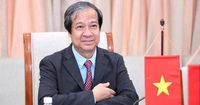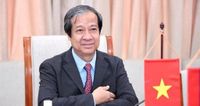Vietnam is set to introduce the Lao language as a new foreign language option in its high schools, beginning with pilot programs in border regions before expanding nationwide. This initiative, announced by Vietnam's Minister of Education and Training Nguyen Kim Son during a reception for Lao Ambassador Khamphao Ernthavanh on June 2, 2025, marks a significant step in deepening the educational and cultural ties between the two neighboring countries.
Minister Nguyen Kim Son revealed that Lao will join the ranks of seven other foreign languages currently taught in Vietnamese schools, including English, Russian, French, Chinese, German, Japanese, and Korean. The pilot program will initially focus on students living in provinces along the Vietnam-Laos border, with plans to expand the curriculum once a sufficient number of qualified Lao language teachers are trained and available.
"We are preparing the necessary conditions to add Lao as one of the eight foreign languages taught in Vietnam's schools," Minister Son said, highlighting the importance of this move in the context of the special relationship between Vietnam and Laos. He emphasized that education is a vital component of the bilateral cooperation, reflecting the longstanding friendship and collaboration between the two countries.
The Ministry of Education and Training is seeking continued support from Laos, particularly in areas such as providing textbooks, teacher training, and curriculum development. This support is critical for the successful rollout of the project titled "Bringing content of historical works on special relations between Vietnam-Laos, Laos-Vietnam into teaching in schools of both countries." This initiative aims to deepen students' understanding of the unique historical and cultural bonds that unite the two nations.
Minister Son also proposed that the Lao Ministry of Education and Sports consider making Vietnamese an optional subject in Laos' high school graduation examinations. Additionally, Vietnam has offered to provide Vietnamese textbooks tailored for schools in Laos that express demand and have the capability to teach the language. This reciprocal educational exchange underscores the mutual commitment to fostering greater understanding and cooperation between the two peoples.
Both countries are actively implementing the "Improving quality and efficiency of Vietnam-Laos cooperation in education and human resource development for the period 2021-2030" project. The year 2025 serves as a milestone, marking the five-year preliminary review of this significant bilateral education initiative. To evaluate progress and plan future directions for 2026-2030, the Ministry of Education and Training is organizing seminars and conferences in both Vietnam and Laos.
In addition, the governments of Vietnam and Laos are strictly enforcing a Memorandum of Understanding on training cooperation. This agreement sets standards for the admission of international students and establishes measures to enhance the quality of education and training. Minister Son stressed the importance of easing administrative hurdles for students from both countries, calling for visa and temporary residence permit fee exemptions for Lao and Vietnamese students, including those receiving scholarships and those who are self-funded, studying in either country.
"Authorities in both countries need to consider creating favorable conditions for Lao and Vietnamese students, including fee waivers for visas and residence permits," Minister Son emphasized. This facilitation will help encourage more educational exchange and cultural interaction between the two nations.
Lao Ambassador Khamphao Ernthavanh expressed gratitude for Vietnam's support in accommodating Lao students. She welcomed the ongoing cooperation and encouraged Vietnamese schools to continue enhancing the management and educational activities for Lao students to ensure a positive and productive learning environment.
According to data from the Lao Embassy in Vietnam, nearly 11,000 Lao students studied in Vietnam during the last academic year, making Vietnam the most popular destination for Lao students abroad. This robust student exchange highlights the strong educational ties and the appeal of Vietnam's academic programs to Lao learners.
Understanding the Lao language's significance adds further context to this educational development. Lao is the official language of Laos, spoken by over 50% of the population, and also used in northeastern Thailand. It belongs to the Tai-Kadai language family, sharing grammatical and tonal similarities with languages such as Shan, Thai, and certain dialects in northern Vietnam and southern China. The Lao language has also been influenced by Sanskrit and regional languages like Vietnamese and Khmer, reflecting its rich cultural heritage.
The Lao script, standardized in the 2003 constitutional revision, serves as the official writing system and is used to record various ethnic minority languages throughout Laos. The language comprises five main dialects: Vientiane Lao, Northern Lao (Luang Prabang), Northeastern Lao (Xieng Khouang), Central Lao (Khammouane), and Southern Lao (Champassak), with Vientiane Lao being the most widely recognized and forming the basis of the standard vocabulary.
Economically, the partnership between Vietnam and Laos is thriving. Bilateral trade reached 2.2 billion USD in 2024, representing a 33.9% increase from the previous year. The first four months of 2025 saw trade surge to 1.3 billion USD, more than doubling compared to the same period in 2024. These figures underscore the growing economic interdependence that complements the deepening educational and cultural exchanges.
Minister Nguyen Kim Son's announcement reflects a broader vision of strengthening Vietnam-Laos relations through education, cultural understanding, and human resource development. By introducing Lao language education in Vietnamese schools and encouraging Vietnamese language learning in Laos, both countries are investing in a future where mutual respect and cooperation flourish.
As the pilot program unfolds in border regions, the success of this initiative will depend on effective collaboration, resource sharing, and sustained political will. The commitment to easing administrative barriers for students and the exchange of educational materials demonstrates a pragmatic approach to overcoming challenges and building lasting ties.
In a world where understanding between nations is more crucial than ever, Vietnam and Laos are setting an example of how education can serve as a bridge, fostering friendship and shared progress. The coming years will reveal how this ambitious language program shapes the experiences of students and strengthens the bonds between these two closely linked countries.






